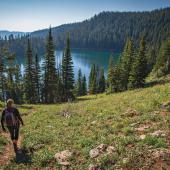Right of Hay
Proper trail behavior around horses.
Interactions between backpackers and horse riders often demonstrate humans’ innate hunter instinct. Most of the time, people kindly follow the trail rules and yield to the horse. To do so, they’ll often crouch, quiet and out of sight behind a bush or tree, on the uphill side of the trail. Although they’re genuinely trying not to frighten the horse, or may even be slightly fearful of it, they’re exhibiting classic predator behavior.
Of course, the horse is already leery of the tall, multiday pack creating a strange and imposing silhouette. Horses can’t see as many colors as humans can, but their eyes are specialized to observe motion on a wide, panoramic horizon. Their hearing is more acute than a human’s, and their sense of smell is keener; it’s likely that a horse is aware of a hiker’s presence well before its rider is.
A horse’s fear escalates as it watches the silhouette of this strange creature get in position to pounce. Horses think like a rabbit: they tend to be frightened of strange or new objects or creatures, and they deal with their fears by fleeing.
To diffuse a horse’s fear, it’s helpful for the rider and the backpacker to converse. Upon encountering a horse and rider, hikers should move into the open and remain on the downhill side of the trail, if possible. Say hello and start a conversation. With young horses, I sometimes give hikers treats to offer my horse. This results in the horse developing a pleasant, positive association with other trail users.
Bikers need to let horseback riders know they are there as soon as possible. If you catch up to a horse from behind, you are very likely to scare it. Horses’ main predators have historically been large cats, which attack from behind. For this reason, horses are typically more fearful of sudden movement or new “creatures” approaching from behind.
If you have a dog with you, try to leash it until the horses have moved beyond the dog’s attention. Even if your dog has experience with horses and can be trusted, not all horses will accept your dog’s presence. Err on the side of caution.
On the part of horse people, they should be polite and share the trail. Many backcountry trails are maintained by pack horses and mules as there are no motorized vehicles allowed. We want to share trails and maintain multi-use so that we can all enjoy the outdoors together safely.
Key Etiquette
Yield the right of way
Restrain your dog
Stay visible to horse and rider
Avoid surprising the horse
Talk to horseback riders as soon as possible
Avoid approaching from the rear, especially without notice
Stop 15-20 yards away from the horse and rider
Move downhill off the trail
Stacie Boswell, DVM, DACVS is a veterinarian at Hardaway Veterinary Hospital in Belgrade.












